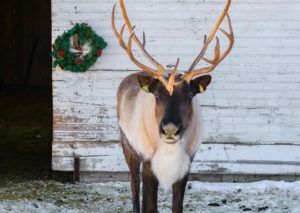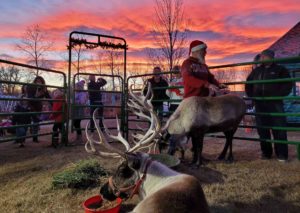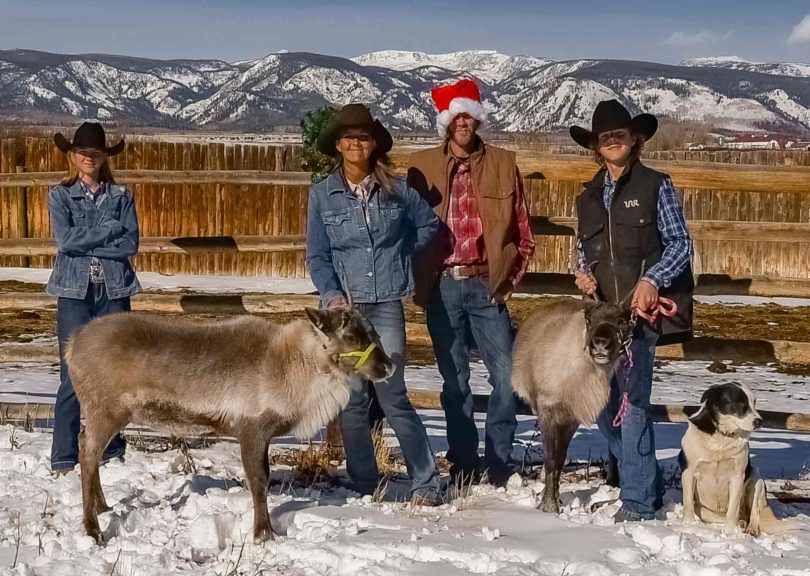By Suzie Romig –
Reindeer on Colorado Ranches Bring Holiday Joy
Most mornings, rancher April Cochrane looks forward to grabbing a green halter and going for a 2-mile walk with her animal companion at her side. That morning ritual is not with the family’s 160-pound guard dog, Clyde, or even with their 70-pound black and white mutt, Kibbles. Cochrane walks with a 100-pound female reindeer named Mouse, one of many reindeer on Colorado ranches throughout the state.
For the first few days in the halter, young Mouse bucked and pulled. But after three weeks, she was fully halter trained.
“I do very much enjoy walking Mouse. It’s relaxing,” Cochrane said.
“Halter training is a long process, and some reindeer are much more difficult than others,” she explained. “Except when we are really busy, I try every morning to put all three calves in their halters and spend at least 15 minutes trying to lead each one individually.”
The Cochrane family — including mom April, husband Dustin and teenagers, Aspen and Harley — live on a 5,000-acre cattle ranch in the unincorporated community of Coalmont southwest of Walden in Mountain Parks Electric’s service territory in Jackson County. The family’s Colorado Reindeer Ranch started with the arrival of its first reindeer in fall 2021. Today there are 12 reindeer on the ranch.
The ranch is one of approximately 10 reindeer operations across Colorado including Noel Productions in Eagle County, Laughing Valley Ranch in Idaho Springs and The Jessen Reindeer Ranch near Loveland.
Statewide Reindeer Revelry
Reindeer ranchers say they fall in love with the usually docile and friendly animals with beautiful antlers and they add them to their existing hobby ranch or agricultural operations. The owners relish showing their reindeer to the public, and December is the perfect month for families to interact with reindeer at public holiday events.

Two active associations, the Reindeer Owners and Breeders Association based in Wisconsin and the Reindeer Farmers Association in Alaska, help support reindeer ranchers and farmers who raise and own the domesticated livestock for hobby or commercial purposes. ROBA Vice President Daryl Simon in Minnesota estimates North America is home to some 150 reindeer operations, with about one-third of those actually participating in breeding to produce calves. The other two-thirds of ranches may care for three or four reindeer for events, Simon said.
“ROBA is dedicated to the promotion of reindeer farming as an agricultural pursuit and serves its members through its website, conferences and publications to provide leadership in maintaining quality standards,” according to the association website.
Farm-raised reindeer are curious and likeable animals that are easy to fence, feed and train to pull, according to ROBA. Reindeer do not require large areas or facilities and can thrive on commercial feeds. ROBA reports reindeer are more common in the northern states but are now raised in many parts of the U.S., including as far south as Texas, Mississippi and Tennessee.
Riverdale Reindeer
Fifth-generation dairy farmer David McIntosh, a United Power consumer-member in Brighton, milks up to 600 dairy cows three times a day, yet last year he added three young reindeer named Kristoff, Juniper and Cranberry, dubbing his operation Riverdale Reindeer.
“I have admired reindeer since I was a young boy, learning everything I could about these amazing and majestic creatures. As my knowledge grew, so too did my desire to one day own reindeer of my own,” McIntosh explained. “Over the last few years, I have met many amazing people who have the same drive and passions for reindeer as I do.”
McIntosh and other ranchers said health issues need to be monitored closely in reindeer, but raising reindeer on Colorado ranches is rewarding.
“I’ve worked with a lot of animals throughout my life, and there is nothing like reindeer,” McIntosh said. “They have a vastly changing personality throughout the year and are beautiful animals. They completely change color from chocolate brown in the summer to silver in the winter.”
McIntosh said he enjoys how his reindeer seem eager to see him each morning and grunt for food. He said his bull likes to eat raisins out of his hand.
“It’s really interesting how they talk to you and tell you what they want,” McIntosh said. “You get really, really attached to the reindeer since you spend so much time working with them and training them.”
The Ropes of Raising Reindeer
Some reindeer ranchers say training and interacting with the animals, which are a smaller cousin to wild caribou, is akin to training a horse. Some longtime owners say they can teach reindeer a few commands, and some have trained them to walk to a mark for a movie or holiday concert appearance.
“Reindeer are time-consuming animals, because the more time you put into a reindeer, the more you are going to get out. Reindeer wouldn’t be reindeer without the human aspect,” said Mike Jablonski, a reindeer rancher for 25 years in New York and current president of the nonprofit ROBA.
“Most of the people (reindeer owners) have a really big heart and care about animals. It’s not about the money; it’s about the animal,” Jablonski said.
The association president noted that raising reindeer for meat in the U.S. is rare since the animals are “worth more per hour (at events) than per pound.”
“Reindeer meat is some of the best meat — lean and tender — but they are worth more in value to me for teaching children and for what they bring to families,” Jablonski said.
The Craft of Raising Reindeer on Colorado Ranches
Aspen Cochrane, 14, attired in a sundress and cowboy boots and walking in the reindeer pens on a warm late summer afternoon in Coalmont, said she prefers reindeer to larger, standoffish cows.
Harley Cochrane, 13, holding a feeding pan with an oat mixture while petting and feeding each reindeer, said he finds the reindeer “calm, interesting and very different from cattle with a different attitude.”
The Cochrane’s ranch, located at 8,200 feet in elevation, has been in April’s family for 33 years. April and Dustin began running the ranch in 2007. They have 300 head of Angus and Hereford cross cattle and grow mountain hay. But these days cattle ranching is not a highly lucrative occupation, so the family decided to add the reindeer operation. That’s in addition to operating a professional sign shop out of their large barn and operating an Airbnb in a renovated 110-year-old farmhouse often used by snowmobilers who explore the Rabbit Ears Pass area to the west.
Many of the bed-and-breakfast guests enjoy hand feeding and petting the reindeer, Cochrane said.
“They’ve never seen a reindeer, and it’s interesting to learn about them. They always wonder about the clicking in their hooves,” Cochrane noted.
The endearing animals make a clicking sound that comes from their ankles when they walk. Experts explain the reindeers’ tendons snap over bones in their feet to produce the clicking that helps the herd stay in contact in a snowstorm.
Colorado owners say reindeer love the winters and eat snow for water. In the summers, owners keep the animals cool with barns or sheds with fans, shade sails, misters or wading pools.
The Cochranes are concentrating on expanding to create a breeding herd. In mid-September, they traveled to Minnesota to pick up three new young reindeer. The family hopes to have five breeding pairs soon and to train several larger reindeer to pull a small sleigh to offer rides for tourists.
In September, two reindeer bulls at the ranch were sans antlers, which were removed to avoid injuries during the two-month rutting season that runs from late summer into early fall. Reindeer have a gestation period of about seven months and give birth in the spring.
Some of the reindeer ranches in Colorado encourage on-site, visitors, yet largely, the ranchers bring their friendly reindeer with their large, picturesque antlers to family-oriented holiday events. Lucky for photographers and fans, reindeer are unique in the deer family in that both males and females grow and shed their antlers each year.
The Jessen Reindeer Ranch
Raising reindeer can be a good bonding experience for families. At The Jessen Reindeer Ranch, the family’s 10-year-old daughter, Maddi, and 8-year-old son, Bodhi, help raise the reindeer calves, owner Chris Jessen said. The whole family recently watched a reindeer give birth.
“We actively, as a family, participate in raising the reindeer, and that’s one of the most rewarding parts to be able to do that as a family,” Jessen said.
The Jessen Reindeer Ranch is in Poudre Valley REA’s territory. Located at 7,000 feet in elevation near Loveland, the ranch raises the second-string team for Santa, according to tales the family likes to tell at holiday events.

“We are Santa’s backup training facility. When his reindeer get tired, Santa lands at our property, and he takes our reindeer and leaves a note of whom he took and where they went,” Jessen said. “He’s used several of our reindeer.”
Jessen, who serves as director of the western region for ROBA, said his family has cared for various domestic pets, livestock and a few exotic animals through the years. They now have two camels just for riding and have raised miniature donkeys, alpaca, miniature cattle and even a kangaroo.
“Perhaps it is Chris’ Norwegian roots that led us to these truly magnificent creatures, or it simply could be that they seem magical by nature. That love led to researching, studying and meeting reindeer ranch owners across the United States,” the ranch’s website explains.
Currently the Loveland area ranch has 10 reindeer that are “our babies,” Jessen said. The reindeer attended eight events last Christmas season ranging from city festivals to corporate parties, but the ranch received 90 additional inquiries.
“We don’t make a living; we like the animals,” said Jessen, who also works as a power system operator for Platte River Power Authority.
Rewards of Raising Reindeer
One indicator of the stability of raising reindeer as an agricultural business is the current healthy price for calves.
Rancher Simon said he sells calves for about $12,000 compared to about $4,000 when he started in the business 29 years ago. Adult reindeer may sell for about $18,000. Simon sells about 12 to 15 calves per year to fellow reindeer operations, but he receives 30 to 40 additional inquiries for calves.
Hannah Fritz, a second-generation deer farmer with a ranch in Eagle County, focuses on the educational exhibition of the domesticated livestock. Fritz said public interest in a unique outdoor experience such as interacting with reindeer expanded during the COVID-19 pandemic.
Jessen said the most rewarding part of reindeer ranching is watching the children who visit the holiday events. He delights in “just the pure magic on their faces seeing an animal that is somewhat of a fairy tale to them that they can meet in person.”
Writer Suzie Romig of Steamboat Springs, who has written several cover stories for Colorado Country Life, will be watching for familiar reindeer flying overhead on December 24.

